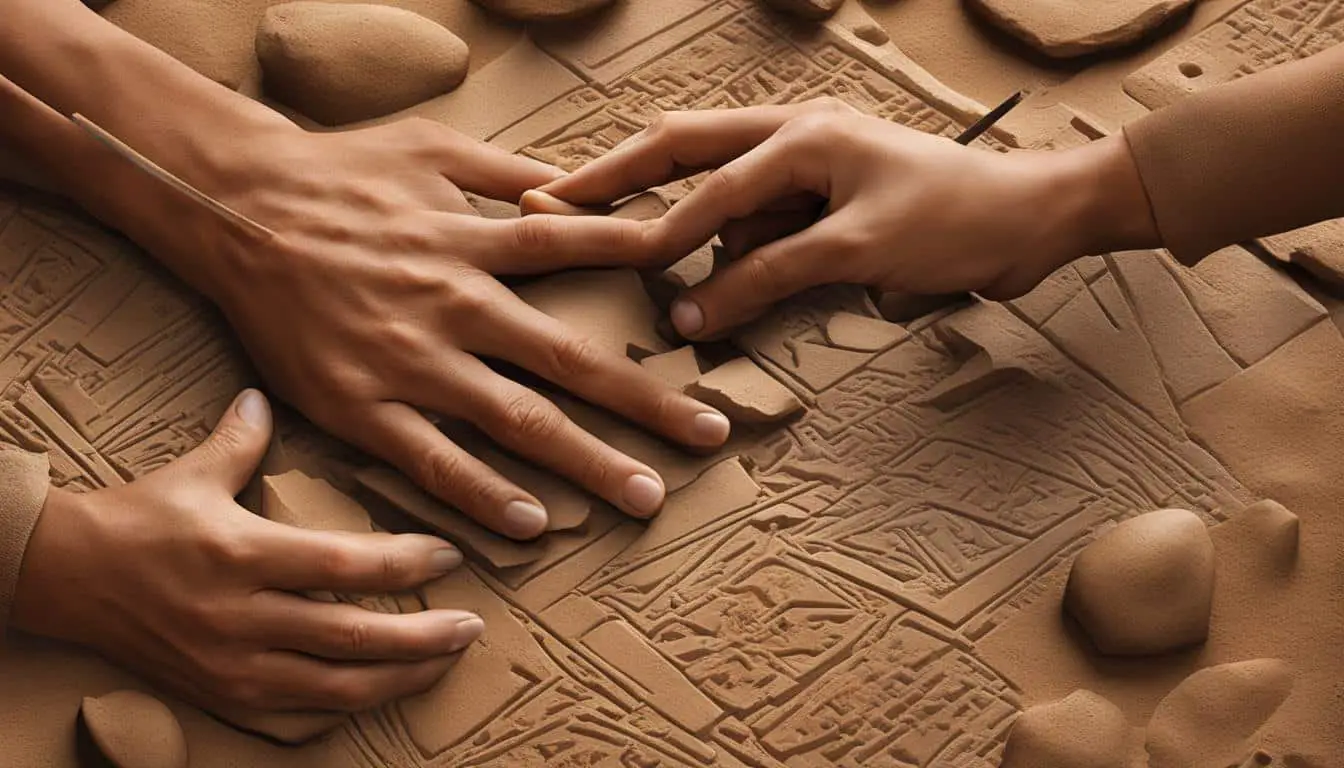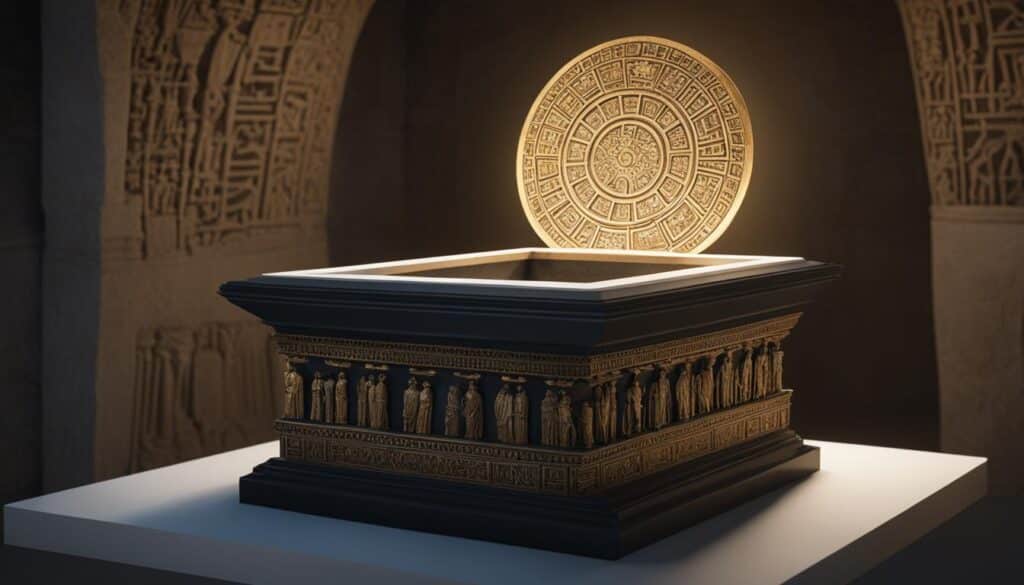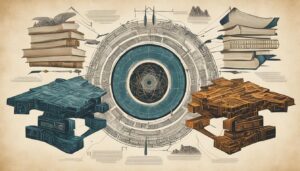
In the intersection of faith and technology lies the fascinating world of digital reconstruction of biblical artifacts. Through cutting-edge techniques, ancient history is brought to life, allowing a global audience to access and appreciate these timeless treasures. In this article, I will delve into the process and significance of digitally reconstructing biblical artifacts, shedding light on the importance of preservation, the techniques used, and the applications in biblical studies. Join me on this journey as we explore the fusion of ancient history and modern technology.
Key Takeaways:
- Digital reconstruction revitalizes and makes accessible ancient biblical artifacts
- Preservation of these artifacts is crucial for safeguarding our cultural heritage
- Techniques such as 3D scanning, photogrammetry, and computer vision are used in digital reconstruction
- Applications include virtual analysis, deciphering faded texts, and creating interactive learning experiences
- The fusion of faith and technology bridges the gap between ancient history and modern understanding
The Importance of Digital Reconstruction in Preserving Biblical Artifacts
Preserving biblical artifacts is of utmost importance to safeguard our cultural heritage and gain a deeper understanding of biblical history. Through digital reconstruction, experts can restore and protect fragile and damaged artifacts, preventing further deterioration while still unlocking valuable insights into the past.
“Digital reconstruction allows us to bridge the gap between the ancient world and the modern era, preserving our rich cultural legacy for generations to come.”
By utilizing advanced digital techniques, such as 3D scanning, photogrammetry, and computer vision, experts can create detailed and accurate virtual models of these artifacts. This digital preservation technique enables researchers and enthusiasts alike to explore the intricate details of these artifacts without risking damage to the originals.
The benefits of digital reconstruction in preserving biblical artifacts are numerous. Not only does it protect these precious pieces from further decay, but it also provides opportunities for in-depth analysis and study. Researchers can uncover hidden inscriptions, decipher faded texts, and gain a deeper understanding of the cultural and historical context, shedding new light on biblical narratives.
The Digitized Experience: Accessible to All
One of the key advantages of digital reconstruction is the accessibility it offers. These digital replicas can be exhibited in virtual museums, allowing people from around the world to explore and engage with these artifacts. Digital archives provide a wealth of knowledge and can be accessed at any time, making this valuable cultural heritage available to a wider audience.
The visual representation of artifacts through digital reconstruction aids in education and learning experiences. Interactive displays and virtual reality applications allow users to immerse themselves in biblical history, fostering a deeper appreciation and understanding of our shared past.
“Preserving biblical artifacts through digital reconstruction ensures that the legacy of ancient civilizations remains alive in the digital age, connecting present and past.”
With the combination of preservation and accessibility, digital reconstruction plays a pivotal role in safeguarding our cultural heritage and promoting the study and appreciation of biblical history for future generations.
| Benefits of Digital Reconstruction | Examples |
|---|---|
| Preserves fragile and damaged artifacts | Restoring ancient scrolls with faded texts |
| Enables in-depth analysis and study | Deciphering hieroglyphics on ancient pottery |
| Creates virtual museum displays | Exploring a virtual reconstruction of the Tabernacle |
| Provides accessibility for a wider audience | Allowing individuals to explore biblical artifacts from their homes |
| Fosters a deeper understanding of biblical history | Interacting with a virtual model of the Dead Sea Scrolls |
Techniques Used in Digital Reconstruction of Biblical Artifacts
Various techniques are employed in the digital reconstruction of biblical artifacts. These techniques play a crucial role in capturing the essence and intricacies of these ancient relics, allowing us to explore and understand their historical significance.
1. 3D Scanning:
The first technique used is 3D scanning, which involves capturing the physical details of an artifact in three dimensions. This process utilizes specialized scanners to create a digital representation of the artifact’s shape, texture, and dimensions. By capturing these physical attributes, 3D scanning forms the foundation for the digital reconstruction process.
2. Photogrammetry:
Photogrammetry is another essential technique in the digital reconstruction of biblical artifacts. By analyzing multiple photographs taken from different angles, experts can reconstruct the object in a virtual environment. Through advanced algorithms, photogrammetry merges these images, enabling the creation of a highly accurate and detailed 3D model.
3. Computer Vision Algorithms:
Computer vision algorithms are employed to process and analyze the data collected through 3D scanning and photogrammetry. These algorithms identify patterns, shapes, and characteristics within the captured data, allowing for the creation of a comprehensive digital model. By leveraging advanced machine learning techniques, computer vision algorithms enhance the accuracy and realism of the reconstructed artifact.
4. Digital Modeling:
Digital modeling is the final step in bringing the reconstructed artifact to life. Through the use of specialized software, experts refine and enhance the digital model, adding details, textures, and colors. This stage offers an opportunity to recreate the intricate designs and embellishments that may have faded or been eroded over time. By meticulously crafting a digital model, the artifact’s original appearance can be faithfully restored.
Combining these techniques results in a comprehensive and accurate representation of the original biblical artifact. This digital reconstruction process allows researchers, historians, and enthusiasts to delve deeper into the historical and cultural context surrounding these ancient artifacts, uncovering invaluable insights that were previously hidden.
| Technique | Description |
|---|---|
| 3D Scanning | Captures physical details of the artifact |
| Photogrammetry | Reconstructs the object using multiple photographs |
| Computer Vision Algorithms | Analyzes and processes the data collected from 3D scanning and photogrammetry |
| Digital Modeling | Enhances and refines the digital model, recreating intricate details |
Applications and Benefits of Digital Reconstruction in Biblical Studies
The applications of digital reconstruction in biblical studies are vast and far-reaching. This innovative technology has revolutionized the way researchers analyze and study ancient artifacts, providing unprecedented insights into biblical history and culture.
Through digital reconstruction, scholars are able to virtually examine artifacts in ways that were previously impossible. By meticulously capturing and rendering intricate details, they can uncover hidden inscriptions, decipher faded texts, and gain a deeper understanding of the cultural and historical context of these artifacts.
One of the major benefits of digital reconstruction is the preservation of biblical artifacts. Fragile and deteriorated artifacts can be delicately restored virtually, ensuring their physical preservation for future generations. This preservation process not only protects the artifacts but also allows researchers to explore and study them without risking damage to the originals.
Digital reconstructions also bring biblical artifacts to life through interactive learning experiences. By creating virtual museum displays and digital archives, these reconstructions can be accessed and appreciated by a wider audience. This accessibility enables individuals from all over the world to engage with and learn from these significant artifacts.
Here is a table highlighting the varied applications and benefits of digital reconstruction in biblical studies:
| Applications | Benefits |
|---|---|
| Uncovering hidden inscriptions and faded texts | Deeper understanding of biblical culture and history |
| Preserving fragile and deteriorated artifacts | Physical preservation for future generations |
| Create interactive learning experiences | Wider accessibility and engagement |
Overall, digital reconstruction has revolutionized the field of biblical studies by allowing researchers to delve deeper into the ancient world. By preserving, restoring, and digitally analyzing artifacts, we continue to unravel the mysteries of biblical history and gain a greater appreciation for our shared heritage.

Conclusion
The digital reconstruction of biblical artifacts offers a remarkable intersection of ancient history and modern technology. Through the preservation and restoration of these artifacts, we gain invaluable insights into the traditions, beliefs, and culture of biblical times. Using advanced digital techniques, we not only protect these precious artifacts but also make them accessible to a global audience, fostering a deeper appreciation and understanding of our shared history.
By employing cutting-edge methods, such as 3D scanning, photogrammetry, computer vision, and digital modeling, experts create comprehensive and accurate digital representations of these artifacts. These reconstructions enable researchers and enthusiasts to explore and analyze intricate details that may have been lost to time.
The applications of digital reconstruction in biblical studies are wide-ranging. Scholars can virtually study and analyze the artifacts in ways not previously possible. Uncovering hidden inscriptions and deciphering faded texts allows for a deeper understanding of the cultural and historical context surrounding the artifacts. Additionally, digital reconstructions open doors to interactive learning experiences, virtual museum displays, and digital archives, ensuring these artifacts can be appreciated by a wider audience.
Through the fusion of faith and technology, the digital reconstruction of biblical artifacts ensures that their timeless significance is preserved for generations to come. By bridging the gap between ancient history and modern technology, we can continue unraveling the mysteries of the past, deepening our connection to our historical roots.
FAQ
What is digital reconstruction of biblical artifacts?
Digital reconstruction of biblical artifacts is the process of using cutting-edge digital techniques to restore and revitalize ancient artifacts, making them accessible to a global audience.
Why is digital reconstruction important for preserving biblical artifacts?
Digital reconstruction plays a crucial role in preserving biblical artifacts by allowing experts to digitally restore and protect fragile and damaged artifacts from further deterioration.
What techniques are used in the digital reconstruction of biblical artifacts?
Various techniques are employed in the digital reconstruction of biblical artifacts, including 3D scanning, photogrammetry, computer vision, and digital modeling.
What are the applications and benefits of digital reconstruction in biblical studies?
Digital reconstruction in biblical studies allows researchers to virtually analyze artifacts in new ways, uncover hidden inscriptions, decipher faded texts, and gain a deeper understanding of the cultural and historical context of the artifacts.
How does digital reconstruction bridge the gap between ancient history and modern technology?
By preserving and digitally reconstructing biblical artifacts, we can gain invaluable insights into the traditions, beliefs, and culture of biblical times while also making these artifacts accessible to a global audience.








